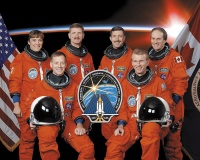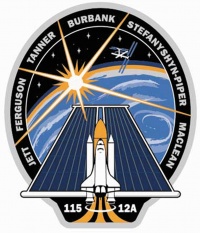STS-115
From The Space Library
 | |
| Organization | NASA-Office of Space Flight (United States) |
|---|---|
| Mission type | Human Crew,Resupply/Refurbishment/Repair |
| Launch date | September 9, 2006 |
| Launch vehicle | Space Shuttle |
| Launch site | Cape Canaveral, United States |
| COSPAR ID | 2006-036A |
| Inclination | 51.6 degrees |
| Experiments | Here |
| Alternate Names | 29391 |
| Additional Information | Here |
| Data Collection | Here |
| Payload Mass Up | 16219.55 kg |
| Payload Mass Down | 444.55 kg |
| Orbiter | Atlantis |
| Lift Off Mass | 2,057,536.36 kg |
| Orbiter Weight at Liftoff | 123,005.45 kg |
| Orbiter Weight at Landing | 90,763.18 kg |
| Landed | 6:21 a.m. EDT, concrete runway 33, Kennedy Space Center, Fla. |
| Orbits of Earth | 187 |
| Orbital Altitude | Approximately 185 nautical miles |
Contents |
[edit] Crew
- Commander: Brent W. Jett
- Pilot: Christopher J. Ferguson
- Payload Commander:
- Mission Specialist 1: Joseph R. Tanner
- Mission Specialist 2: Daniel C. Burbank
- Mission Specialist 3: Steven G. MacLean, Canadian Space Agency (CSA)
- Mission Specialist 4: Heidemarie M. Stefanyshyn-Piper
- Mission Specialist 5:
- Payload Specialist 1:
- Payload Specialist 2:
ISS/Mir Crew Transport
[edit] Mission
STS 115 is an American Shuttle craft that was launched from Cape Canaveral at 15:15 Ut on 9 September 2006. It transported six astronauts to the International Space Station, along with a structural 17 tonne truss with two large solar panels of total length 73 m, to enable more modules to be attached. The astronauts made three space-walks to attach the truss and solar panels, and make the electrical connections with the help of the robotic arm. These exercises went well except for minor glitches such as the loss of some bolts and nuts. They also examined all exterior surfaces on the Shuttle to assure that it had not suffered any significant damage to its heat shield during the launch. The Shuttle, with all the six astronauts landed back in Cape Canaveral at 10:21 UT on 21 September, after 11 days on the ISS.
[edit] EVA
Extravehicular Activity (EVA) conducted by Heidemarie M. Stefanyshyn-Piper, Joe Tanner, Dan Burbank, and Steve MacLean during three spacewalks for a total of 20 hours, 19 minutes. EVA 1, 6 hours, 26 minutes; Piper and Tanner connected power cables on the truss and released the launch restraints on the solar array blanket box, beta gimbal assembly, and solar array wings. They also configured the solar alpha rotary joint (SARJ), an automobile-sized joint that allows the station's solar arrays to turn and point toward the Sun. EVA 2, 7 hours, 11 minutes; Burbank and MacLean devoted the spacewalk to the final tasks required for activation of the SARJ. EVA 3, 6 hours, 42 minutes; Piper and Tanner installed bolt retainers on the P6 beta gimbal assembly, which helps to orient the pitch of the solar array wings, and retrieved the Materials on the International Space Station Experiment 5.
[edit] Payload
ISS Assembly Flight 12A; ITS P3 and P4, second port truss segment, second set of solar arrays and batteries. This addition added 45 feet to the ISS and increased the wingspan to more than 240 feet.
[edit] Books about the Space Shuttle Program
Buy This Book Click here |
Buy This Book here |
Buy This Book Click here |
Buy This Book Click here |





